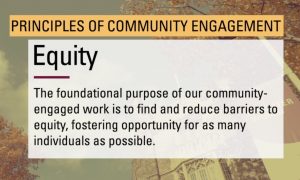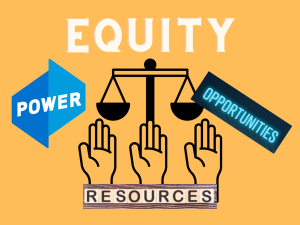Chapter 9: Equity

The principle of equity asks that participants in community-engaged learning recognize that different people inhabit different lived circumstances driven by a set of broad structural forces. These forces impact individuals, communities and institutions and include racism, colonialism, gender discrimination, heteronormativity, ableism, ageism and socioeconomic discrimination.
An equity analysis asks community-engaged participants to acknowledge that in every interaction there are power imbalances mediated by these structural forces. An equity analysis asks community-engaged participants to acknowledge that in every interaction there are power imbalances mediated by these structural forces. These power imbalances create barriers to full participation and access to the necessary conditions and levers to create change. In community engagement work, we use an equity analysis for a few key reasons:
- Oftentimes, community engagement is required because something needs to change; a group of people or community is experiencing injustice or lack of resources. An equity analysis lets us understand the root causes of those conditions so that change is more impactful and sustainable.
- In terms of participation in community engagement, an equity analysis helps us identify issues of access and inclusion for community members based on how their identities interact with those structural forces. In this, barriers to participation are mitigated and, longer term, the conditions that create those barriers are eradicated.

Considering issues of equity helps us understand community needs more thoroughly and can lead to lasting change. You may feel that the larger structural problems are outside of your grasp as you conduct your community engagement project. This is natural! Have faith that every small piece is important and your learning now will contribute to your greater understanding of power structures and inequity.
Hannah talks about her experiences with Frontier College’s literacy programs in this short video clip (access to closed captions in toolbar):
Watch the whole 27-minute video, “The Principles of Community Engagement Module” [27:38].
Checklist: Equity
Here are some questions you might ask yourself when considering the principle of equity in your community engaged learning experience:
- How do my identities (race, gender, sexuality, class) matter in terms of this work? How might community members perceive my participation?
- What broader power structures affect this issue and how does the community participate in this issue? What are common assumptions and biases about this issue? What perspectives may be missing and why?
- Is everyone able to participate equally in this process? What are the barriers and how can we use an equity approach to mitigate those barriers and ensure participation?

